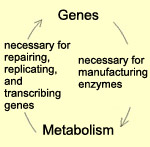Tuesday, 28 March 2023
The interactions between DNA and proteins

This week, I’d like to say a few words about an important change from the way that the interactions between DNA and proteins were long thought of.
We have now come a long way from the simplistic linear understanding that we had from the start of genetics, in which the “genetic program” of DNA was copied into messenger RNA which then exited the cell nucleus and was translated into proteins in the cytoplasm. As we have just seen, the reality is more of a complex metabolic network subject to a circular logic that assumes no “program” and hence no absolute starting point. In other words, we must now discard this “genocentric” heritage according to which DNA is the foundation of everything, because it provides the building plans.
In the early 1970s, Henri Atlan was one of the first to do so, when he drew attention to the fact that DNA cannot be equated with a plan or a program, because it is a program that has need of its products. DNA is just one molecule among many others in an immense network—an especially stable molecule, to be sure, and a complex macromolecule that carries a lot of information. But that does not give it the superior status as an all-powerful replicator that some authors have wished to ascribe to it, in particular Richard Dawkins in his 1976 book The Selfish Gene. Many aspects of this conception have given rise to numerous debates and criticisms, such as here, here, here, here, here and here, as well as by paleontologist Stephen Jay Gould, the “evo-devo” approach and the theory of dynamic systems.
From the Simple to the Complex | Comments Closed







